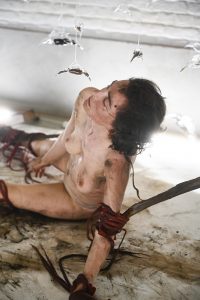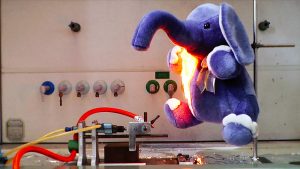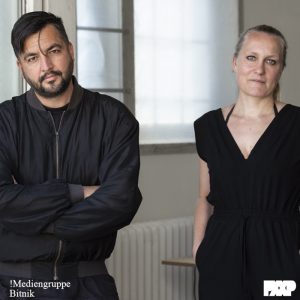Wow! That was a fantastic talk. I wish more artists could talk about their work with so much passion and sense of humour. The talk of Australian performance artist Stelarc, titled Fractal Flesh – Prototyped, printed and phantom bodies, presented his work in a thematic way.
He explained how his performances explore the body as an evolving architecture. In our era, bodies can be extended in different ways: plastination enables us to conserve corpses and the advance of medicine allow for the life of a comatose patient to be extended for a long time.
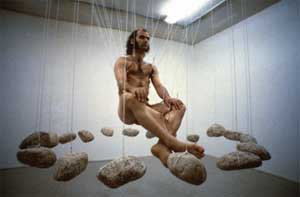 The Suspension performances where his naked body was suspended in the air by inserting fishhooks into his skin were done 27 times over a period of 13 years and each time at a different location. He called it a “posture of indifference”: the body’s awareness is extruded and its operation is extended into the realm of the absent, the involuntary, the alien. In a performance in Copenhagen (video), the body of the artist (he actually talks about himself as “the artist”) was suspended 60 meters high using a crane from street level. Heartbeat and blood flow were amplified with multi sound sensors to produce a soundscape. As he got gradually exhausted from the performance the heartbeat quickened, breath shortened and so the soundscape evolved.
The Suspension performances where his naked body was suspended in the air by inserting fishhooks into his skin were done 27 times over a period of 13 years and each time at a different location. He called it a “posture of indifference”: the body’s awareness is extruded and its operation is extended into the realm of the absent, the involuntary, the alien. In a performance in Copenhagen (video), the body of the artist (he actually talks about himself as “the artist”) was suspended 60 meters high using a crane from street level. Heartbeat and blood flow were amplified with multi sound sensors to produce a soundscape. As he got gradually exhausted from the performance the heartbeat quickened, breath shortened and so the soundscape evolved.
The rock suspension of the body was counterbalance by the wreath of rocks, one rock for each insertion point. The body was gently swaying from side to side, setting up random oscillations in the rocks. Stelarc decided to stop the performance when he heard a phone ring in the gallery. They did it anyway. His body was rolled out of the window of a building. After 5 minutes he could see the police cars arriving. Police then erupted in the apartment and asked for his ID which given his situation at the time was rather difficult to produce!
In an abandoned space in Brisbane, he made a more complex performance using a control box that allowed him to choreograph his body movement through the space. He could hoist his body up and down travel in any direction. He could also propel it forward, turning his body into a kind of projectile in the space. Also by starting and stopping the body suddenly he could get the body to swing from side to side. The performance was about 30 minutes. There was hardly any bleeding. You just have to avoid to insert the hook into the muscles.
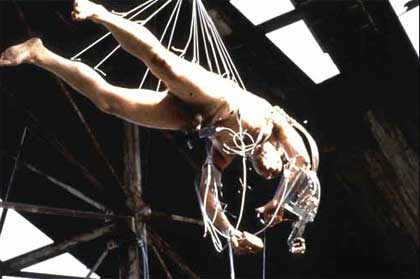
At an abandoned monorail station in Japan, he did a suspension with the third hand attached and controlled using his muscle signals (abdominal electrodes allow independent movements of the third hand.). He could control the up and down movements of his body. The sounds of the third hand and the body signals were amplified to produce a soundscape.
These performance were usually done without an audience, only people who happen to pass in the area by chance would see him naked, hooked and suspended. In NYc and Copenhagen, however, the performances were financed by galleries and festivals so they had to be public.
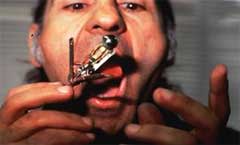 In 1993, he participated to the Australia Sculpture Trienalle. The theme was: site-specific works. As ususally he went for the extreme and had a Stomach Sculpture specially-designed for and inserted into the body (video). The sculpture was inserted approximately 40 centimeters inside the stomach cavity. The sculpture was a very simple mechanism driven by a plexidriver cable to a servo motor and a logitech circuit outside the body (not all the parts were small enough to be inserted inside the body). The body became the host of the art work. Instead of a sculpture for a public space, he made one for a private physiological space. Instead of having the technology attached to the body (cf. Third Hand), technology was invading the body. It was inserted into the body not for some medical necessity, but simply through some artistic choice.
In 1993, he participated to the Australia Sculpture Trienalle. The theme was: site-specific works. As ususally he went for the extreme and had a Stomach Sculpture specially-designed for and inserted into the body (video). The sculpture was inserted approximately 40 centimeters inside the stomach cavity. The sculpture was a very simple mechanism driven by a plexidriver cable to a servo motor and a logitech circuit outside the body (not all the parts were small enough to be inserted inside the body). The body became the host of the art work. Instead of a sculpture for a public space, he made one for a private physiological space. Instead of having the technology attached to the body (cf. Third Hand), technology was invading the body. It was inserted into the body not for some medical necessity, but simply through some artistic choice.
The sculpture had a flashing light and a beating sound. It is about 15 mm in length and 15 millimeters in diameter but fully opened it is about 50 mm in diameter and about 75mm long. The video was done using an endoscope.
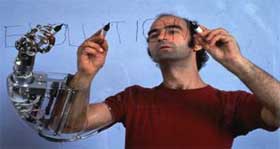 The Third Hand was attached to his body. It is controlled by abdominal electrodes, that allow independent movements of the apparatus.
The Third Hand was attached to his body. It is controlled by abdominal electrodes, that allow independent movements of the apparatus.
Completed back in 1980, the new extended arm manipulator has wrist rotation, thumb rotation, individual finger flexion and each finger opens and closes. So each finger can be a gripper in itself. This time the body is extended with a new manipulator. In a performance he used his three hands to write the word “Evolution.” Was quite tricky especially as he had to learn how to write back to front because he was writing the word on a glass panel in front of the audience.
A 1995 work was using a touch screen interface that allowed people at the Centre Pompidou in Paris, at the Media Lab in Helsinki and at the conference Doors of Perception in Amsterdam to access his body in Luxembourg and by touching the muscles on the computer model program the choreography of his remote body. He could see the face of the person who was moving him, and they could see his body movements or their choreography. The body became a kind of host for a remote agent. People in the three cities were able to access and move the body over a period of three days. Only his right leg could not be activated (he needed it to stand on!)
The Ping Body performance used the ping internet protocol to activate the body through internet data. During the performance he would ping 40 global sites. The signals were mapped to the body muscles and the body thus became a crude barometer of internet activity. The body moved according to the internet activity.
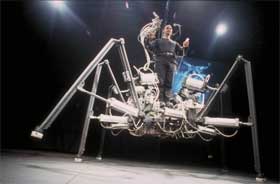 The Exoskeleton was inspired by insects. It is a six legs walking machine that translates body movements into machine legs motions.
The Exoskeleton was inspired by insects. It is a six legs walking machine that translates body movements into machine legs motions.
The Walking Head: an autonomous robot with an LCD screen and a computer whose facial behaviour depends on the movements around. As visitors enter a dark room, the eyes of the face open and starts to communicate with the person and the robot moves. It then sits down, closes its eyes and waits for the next person to enter the room (images).
Talking about robots, he showed us a video of a fantastic robot developed at the University of Cleveland. It uses both wheels and legs to move superfast, it can tumble down the stairs without any damage and it can move equally well on either side.
He presented a rather weird work called Blender. He met Nina Stellar one day at the morgue, she was carrying a human arm. Her job is to cut up body parts for medical students. Both artists had content of their body removed (blood, subcutaneous fat, nerves, connective tissues). It was actually very difficult to obtain the body liquids. As soon as body content are outside your own body they are labelled as “bio-hazardous material”. The installation was human high, it was composed of a blender and four oxygen tanks. The material removed from the artists was mixed every 5 minutes. After that the protein would go back to the bottom of the glass bowl and the fat would sit at the top. It’s the opposite of the Stomach Sculpture, as this time it’s the machine that contains bits of human body.
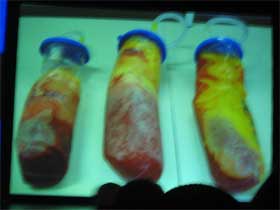
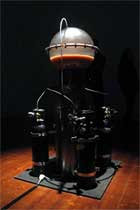 The Extra Ear project dates back to 1996 so it took him nearly 10 years to find surgical assistance to realize the project as the process goes beyond cosmetic surgery. He was first planning to place the ear on his cheeck, next to his actual ear because the jawbone contains too many facial nerves which made it too risky (he could have half of his face paralysed) and ridiculous (the extra ear would wiggle each time Stelarc would speak or chew.) The idea is to construct an ear using skin cartilage taken from his thorax. Together with SymbioticA and Tissue Culture & Art Project they deided to grow a small replica of the ear using cells. They made a cast of the ear, scalled it down, used scaffold to give the cell and ear shape, put it inside a rotating bio-reactor and fed the growing ear with nutrients regularly.
The Extra Ear project dates back to 1996 so it took him nearly 10 years to find surgical assistance to realize the project as the process goes beyond cosmetic surgery. He was first planning to place the ear on his cheeck, next to his actual ear because the jawbone contains too many facial nerves which made it too risky (he could have half of his face paralysed) and ridiculous (the extra ear would wiggle each time Stelarc would speak or chew.) The idea is to construct an ear using skin cartilage taken from his thorax. Together with SymbioticA and Tissue Culture & Art Project they deided to grow a small replica of the ear using cells. They made a cast of the ear, scalled it down, used scaffold to give the cell and ear shape, put it inside a rotating bio-reactor and fed the growing ear with nutrients regularly.
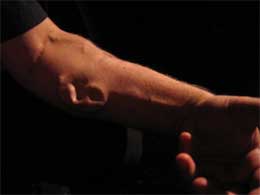 The ear was seeded in Perth but at some point it had to travel. The trick was to keep it constantly at body temperature so they put it in the underwear of the person who was carrying it. There was fortunately no body check at the airport.
The ear was seeded in Perth but at some point it had to travel. The trick was to keep it constantly at body temperature so they put it in the underwear of the person who was carrying it. There was fortunately no body check at the airport.
Beginning of last year he got the opportunity to get funding for the project and attached the ear on the forearm of the artist. The operation requested 3 surgeons on 2 and a half hours. He first had a microphone implanted in it but had to be removed temporarily because of infection.
The idea is to have the microphone connected to a bluetooth wireless transmitter. When they first tested it at the hospital, it was working quite smoothly even if the ear was wrapped in bandage. The system would allow people in remote place to hear what the extra ear is listening to. If you phone him with your mobile phone, Stelarc could speak to you through his extra ear. Speaker and receiver would be placed in a gap between his teeth: when his mouth is closed, only he would hear the phone conversation; with the mouth open, the voice of the caller could be heard through Stelarc’s mouth.
Images from Stelarc’s talk at Transmediale.


![7 art and tech ideas I discovered at Meta.Morf 2024 – [up]Loaded Bodies 7 art and tech ideas I discovered at Meta.Morf 2024 – [up]Loaded Bodies](https://we-make-money-not-art.com/wp-content/uploads/2024/05/53705969154_73dfdfea6f_c-300x200.jpeg)
